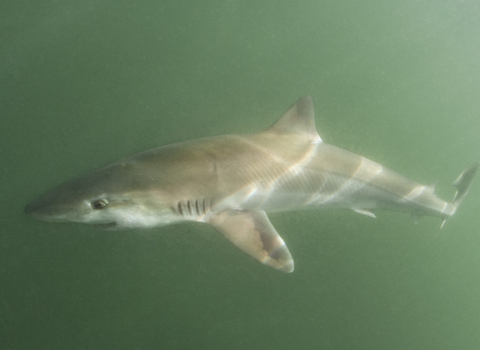
Tope ©Peter Verhoog
Tope shark
Scientific name
Galeorhinus galeusWhen to see
January to DecemberSpecies information
Statistics
Length: Up to 195cmWeight: 45kg
Average Lifespan: Can live for over 50 years
Habitats
About
The beautiful tope shark isn't exactly what you'd call a picky eater! They feed on a variety of fish species but will also take crustaceans or cephalopods if the opportunity arises. Tagging studies have shown that Tope can travel huge distances and some individuals tagged in the UK have later been found as far away as the Canary Islands!How to identify
A long and slender shark with a grey upper body and a white belly. The tope shark has two dorsal fins and a distinctive notched tail.Distribution
Found around all UK coasts, though more common in the South and West.In our area
In the Autumn, Tope migrate to our waters and can be found throughout the Irish Sea. The local population has declined dramatically in recent years, particularly within Strangford Lough and Carlingford Lough which historically supported major tope fisheries. There is evidence that both Strangford Lough and Carlingford Lough are pupping grounds for the species because of the relatively high catch of large females and small juveniles during Autumn and Winter. Critical areas such as pupping grounds need to be protected because this is an area that sharks live in when they are most vulnerable. As Tope are on the NI Prioirty Species list we hope to be able to provide evidence through our tagging programme that will ensure spatial protection measures for them.
Did you know?
There has never been any record of an unprovoked Tope attack on humans, so no need to fear this elegant elasmobranch.In the Autumn, Tope migrate to our waters and can be found throughout the Irish Sea. The local population has declined dramatically in recent years, particularly within Strangford Lough and Carlingford Lough which historically supported major tope fisheries. There is evidence that both Strangford Lough and Carlingford Lough are pupping grounds for the species because of the relatively high catch of large females and small juveniles during Autumn and Winter. Critical areas such as pupping grounds need to be protected because this is an area that sharks live in when they are most vulnerable. As Tope are on the NI Prioirty Species list we hope to be able to provide evidence through our tagging programme that will ensure spatial protection measures for them.
